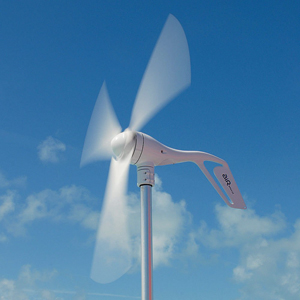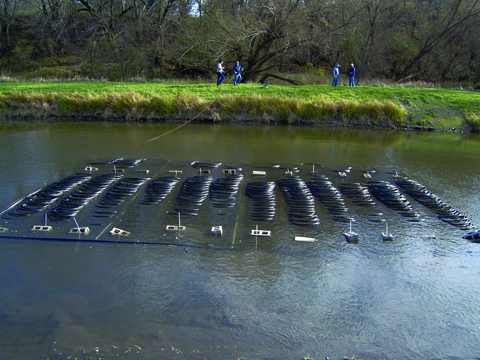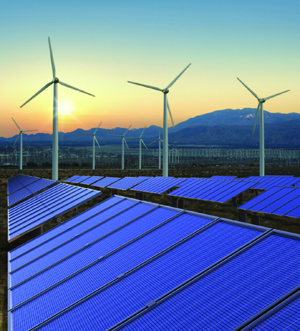Going green is easy these days, especially when you are building a new home. With the cost of fossil fuels increasing annually and the damage they cause the environment more evident every day, it’s a good time to reduce your carbon footprint, save some money on utilities, and make your living environment comfortable and healthy.
Adding an alternative energy system to a log home is no more difficult than installing a standard HVAC system, but it does require a different set of skills and equipment. You’ll need to have a professional evaluate your building site, work out the best system for your needs, and install it so that it works for you problem-free. A lot of information is available in books, magazines and on the Web, so do as much research as possible before you decide what system(s) you are interested in.
Many log home companies offer alternative energy systems with their homes. If they don’t, they will be more than willing to work with you on whatever system you choose. It’s important that the system be designed into your building site and floorplan so that any variations in standard equipment, space needs, and installation procedures are accommodated.
In some cases, the up-front costs for purchasing and installing an alternative-energy system are higher than those for a traditional system. These costs can be offset with tax incentives from the U.S. government and/or the state in which you are building and rebates from manufacturers and/or utility companies. In addition, you may be able to add the cost of the system to your mortgage. It may add a few dollars to your monthly payments, but your lower utility bills will make that acceptable.
To start you on your way toward choosing an alternative energy system for your new log home, here is a brief overview of three of the options: solar, wind, and geothermal.
Solar Energy: Photovoltaics (PVs)
How It Works
Photovoltaic materials and devices convert light energy into electrical energy. A PV system begins with a single semiconductor cell that produces 1-2 watts of power. The cells are connected to form modules and modules are joined to create arrays that can be used alone or joined together into an even bigger array. Depending on the size of the array, it can provide enough electricity to power an individual home or an entire city.
Components
Array, charge controller (regulates voltage), inverter (coverts DC to AC), storage batteries.
Your Site
The solar array needs maximum southern exposure to the midday sun in all seasons. To accomplish this with a roof-mounted system, your home will need to be on an east-west axis. Any trees, hills, or other structures that block the sun will affect the efficiency of the PV system. If you plan to locate the array away from the house, it will need a suitable area, preferably within 100 feet of the home. The farther away it is the more expensive it will be to run the wire from the array to the house. To make sure your site is appropriate for a PV system, consult with a solar energy professional. The pro will design the optimal system for your home and your energy needs and set up the array and the rest of the components for trouble-free operation.
Your Home
You should have your PV system designed before you start on the plans for your log home. Installation is just as easy as putting in a standard HVAC system, but there are a few space considerations. If your system includes storage batteries, they will need to be located in a well-ventilated area or be vented to the outside. At some point you may want to expand your battery bank so you’ll need to plan for the extra space. Weight is not an issue for a roof-mounted solar array, but your roofing material will determine how the panels are installed. They attach more easily to metal or shingle roofs.
Pros and Cons
Once it is installed, your PV system will require little maintenance. But the panels will need to be cleaned periodically and kept free of leaves, dirt, etc. Since a PV system is modular, it can be added to as your needs increase or change—and you can start small and add to the system as your finances allow. If you are building in a community or neighborhood, make sure the regulations allow you to have a PV system on the roof or on your property.

Wind Power
How It Works
A wind turbine converts kinetic energy into mechanical energy, i.e., the spinning rotors on the wind turbine catch the power of the wind and turn it into motion. The power generated by the turbine is either stored in a battery bank to run lights and appliances or it can be used directly to heat interior spaces and water.
Components
Rotor, frame-mounted generator or alternator, tail, steel tower, electrical wiring and controllers, inverters, and batteries.
Your Site
To install a wind turbine large enough to provide a large part of the electricity for your home, you’ll need at least a one-acre site. You will need a professional evaluation of your site to determine if the wind volume and speed are sufficient to produce the power your home requires. Small variances in wind speed increase the available power, but trees, your home, and hills and outcroppings reduce wind speed. A professional should also determine where to locate your turbine. It should be up wind of houses and trees with the tower at least 30 feet above anything within 100 yards of the tower. You also need to consider how close to the house you’ll locate the turbine. The farther away it is the more expensive the wiring and cables will be.
Your Home
The pros don’t recommend mounting a wind turbine on the roof because of the vibration and wind turbulence. The turbine can be close to the house at roof level with the tower running straight to the ground and supported by the house. When you are designing your home, you have the same issues as with a PV system: space for the equipment and battery bank with room for expansion.
Pros and Cons
A wind power system can save you as much as 50 to 90 percent on your utility bills, make stringing power lines to your new home or a remote site unnecessary, prevent power outages, and reduce greenhouse gases. A wind system can be combined with a solar energy system to take advantage of opposite extremes of climate. Equipment and installation costs are high, but it costs little to nothing to operate the wind turbine. The system should last for 20-30 years. On the down side, land use laws, building code, and zoning may not allow a tower of the height you need. A medium-size turbine makes a loud swishing noise that your neighbors may not appreciate, though much of it is masked by the wind. Because of its size and motion, a turbine can be dangerous, so it is imperative to have it installed and secured by a professional. If your property is prone to gale-force winds, a wind turbine is not for you.

Geothermal (Ground Source) Heat Pumps
How It Works
Pipes buried underground access the earth’s consistent temperature (50-55 degrees F).
The heat pump extracts the heat and distributes it as warm air via conventional ductwork throughout the home. For cooling, the process is reversed: heat is removed from the air and moved back through the underground pipes or used to heat water. The system uses underground loops to transfer the heat, so there is no venting, no flammable fuel, and no fuel storage tanks.
Components
Heat pump, heat exchanger, loop system, and ductwork.
Your Site
A geothermal heat pump system can be installed in almost any location and on any size lot. If you have the space on your lot, the pipes are buried in trenches 100- to 400-feet deep—a horizontal loop. If land surface is limited, well-drilling equipment is used to make the holes for the pipes, also 100 to 400
feet deep. If you have a pond on your property or are building on a lake, the coils and pipes can be submerged in the water.
Your Home
The system takes up the same amount of space as traditional HVAC, but you should consult with a professional to determine the required ductwork before your log home design process begins.
Pros and Cons
The Department of Energy and the Environmental Protection Agency have endorsed ground source heat pump systems as one of the most energy-efficient and eco-friendly systems available. It takes the place of conventional heating/cooling and hot water heating systems, and all the components are buried or inside the house. The maintenance costs are low, and you will see up to a 50 percent reduction in utility bills; this will help offset the higher initial costs of installing the system. The components inside the house have a life expectancy of 25 years while the underground elements should last for 50 years or more.

